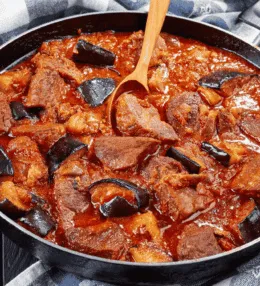
- View
Table of Contents
ToggleSpätzle, Germany’s beloved egg noodle, is the kind of dish that brings warmth to the heart and comfort to the table.
Soft, tender, and incredibly versatile, these noodles are a staple in southern Germany, especially in Swabia and Bavaria, where they accompany hearty stews, roasted meats, or rich cheese sauces. Spätzle’s simplicity is its charm, making it a dish that feels both rustic and refined, a true taste of German culinary tradition.
Want to dive deeper into German Cuisine? Don’t miss our post on 33 Traditional German Foods to Try
What Is Spätzle?
Spätzle, pronounced “shpet-zleh,” are soft egg noodles made from a simple dough of flour, eggs, and water. The dough is thicker than traditional pasta dough, which gives Spätzle its distinct, slightly chewy texture.
Unlike long strands of spaghetti or fettuccine, Spätzle is irregular in shape, created by pressing the dough through a colander or Spätzle maker directly into boiling water. The result is a collection of small, pillowy noodles with a uniquely rustic appearance.
Spätzle is a culinary chameleon, able to pair with a wide variety of dishes. It’s often served as a side dish, soaking up the flavours of rich gravies and sauces.
One of the most popular variations is Käsespätzle, where the noodles are layered with melted cheese and caramelized onions, a German answer to mac and cheese that’s as indulgent as it is satisfying. Whether enjoyed plain with butter or as part of a more elaborate dish, Spätzle is a crowd pleaser that never fails to deliver.
Ingredients and Taste
Spätzle relies on a handful of ingredients: flour, eggs, water, and a pinch of salt. The richness of the eggs gives the noodles their characteristic yellow hue and slightly dense texture.
The dough is soft and sticky, allowing the noodles to remain tender after cooking. A bit of nutmeg is sometimes added for a subtle hint of warmth and complexity. The flavor of Spätzle is delicate, with the eggs providing a mild richness that makes it an excellent canvas for bolder ingredients.
When served with butter or cheese, the noodles take on a comforting, creamy quality. If paired with meat or gravy, they act as the perfect sponge, soaking up the savoury flavours without losing their texture.
The taste is simple yet deeply satisfying, making Spätzle a versatile addition to both everyday meals and special occasions.
A Taste of History
Spätzle has a history as rich as the dishes it complements. Its origins lie in the Swabian region of southern Germany, where it has been a culinary staple for centuries.
The word “Spätzle” is thought to derive from the German word “Spatz,” meaning sparrow, perhaps referring to the irregular shape of the noodles. Historically, Spätzle was considered a dish of the common people, made from affordable and accessible ingredients, yet prepared with care and skill.
Over time, Spätzle evolved from a humble meal into a beloved part of German gastronomy, served in homes and restaurants alike. Its popularity spread across borders, becoming a cherished dish in neighbouring countries such as Austria and Switzerland.
Today, Spätzle remains a symbol of Swabian heritage and is celebrated in annual festivals and family traditions.

German Spätzle (Egg Noodles)
Equipment
- Mixing bowl
- Wooden spoon or spatula
- Spätzle press, colander, or coarse grater
- Large pot
- Slotted spoon
- Skillet
Ingredients
- 300 g all-purpose flour
- 1 tsp salt
- 3 large eggs
- 100 ml whole milk
- 2 tbsp butter for sautéing
- Fresh parsley chopped (optional, for garnish)
Instructions
- To begin, sift the flour and salt into a large mixing bowl. This ensures the flour is light and free from lumps, making it easier to incorporate the wet ingredients. Create a well in the centre of the flour for the next step.
- Crack the eggs into the well and pour in the milk. Using a wooden spoon or spatula, mix the ingredients from the centre outward until a smooth, sticky dough forms. Avoid overmixing, but ensure there are no dry pockets of flour. The dough should be thick yet elastic.
- Bring a large pot of salted water to a gentle boil. Prepare a colander, Spätzle press, or coarse grater for shaping the dough. If you don’t have these tools, a flat wooden board and knife can be used to create rustic noodles.
- Working in batches, press or scrape small portions of the dough into the boiling water. The Spätzle will sink to the bottom initially and float to the surface when cooked, typically after 2-3 minutes. Use a slotted spoon to transfer the floating noodles to a colander.
- Once all the Spätzle has been cooked, rinse them briefly with cold water to stop the cooking process. This also helps remove excess starch, ensuring the noodles remain separate and do not clump.
- In a large skillet, melt the butter over medium heat. Add the cooked Spätzle and sauté for 3-5 minutes, stirring occasionally, until lightly golden and slightly crisp in spots. This step enhances the flavour and texture of the dish.
- Taste the Spätzle and adjust seasoning with additional salt if needed. For a traditional touch, sprinkle freshly chopped parsley over the noodles before serving. You can also add a pinch of nutmeg for a deeper, more authentic flavour.
- Serve the Spätzle warm as a side dish to hearty German mains like schnitzel, sauerbraten, or bratwurst. For added indulgence, pair with a creamy sauce or top with caramelized onions and grated cheese. Garnish with parsley for a vibrant finish, and enjoy with a chilled glass of German Riesling or beer for an authentic dining experience.
Nutrition
You May Also Like






